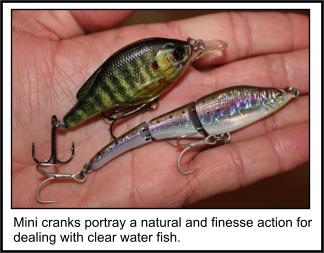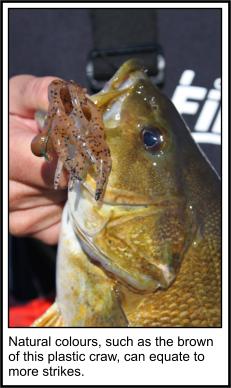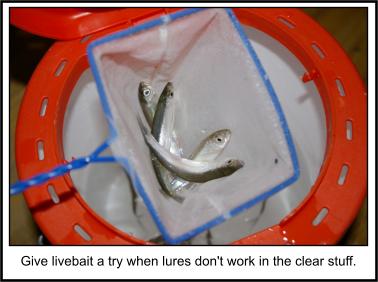|
Refine Your Tactics for Clear Water Conditions
Justin Hoffman
Water conditions are a fact of life for any angler and,
whether good or bad, are ultimately out of our control.
But by changing the way we think and act out on the boat
can put the odds in our favor – and a sweet pull on the
line. Clear water comes with its own set of rules.
Fish can be finicky, spook easily, or drop down deep.
Learning to adapt is a key concept that can greatly
increase fishing success during these times – and help
you overcome the clarity conundrum.
Clear Water Concerns
Clear water can be enjoyable to fish in.
Visibility is greatly enhanced, sight fishing becomes a
possibility, and watching and interpreting your lure or
bait is much more feasible. But with these luxuries come
some negatives. Fish are able to inspect your lure much
more intently. The same goes for line. They can be
skittish or spook easily, both by errant casts or angler
and boat movement.
 Seeking
shelter or sulking down deep is also a common
occurrence, especially on days when the sun is up high
and shining or from an increase in angler pressure. All
of these ‘negatives’ can be rectified, however, by
making some minor adjustments. Seeking
shelter or sulking down deep is also a common
occurrence, especially on days when the sun is up high
and shining or from an increase in angler pressure. All
of these ‘negatives’ can be rectified, however, by
making some minor adjustments.
Downsize Baits
Big, flashy lures certainly work well in
stained or muddy water conditions, but small is the word
when working the clear stuff. Since fish can thoroughly
inspect a lure when visibility is great, give them
something that looks unnatural and they will almost
certainly shy away from it.
A downsized bait will not only appear more life-like in
the water, but its action and motion will be much more
natural. This is key to getting bit.
Mini crankbaits, micro plastics and thin profile baits
all work well under these conditions. In terms of bass,
tossing a 2” jerkbait, small tubes or lizards, or even
dragging a drop shot rig with a pint-sized bait will up
your odds for getting bit. For northern pike, a 4”
soft stick bait, tube jig or downsized bucktail are
excellent options. Whatever you normally use, get in the
habit of dropping down a size or two. It will make all
the difference.
 Color
is Key Color
is Key
Natural hues work best when working clear water
as they lend themselves to a more natural appearance.
Try your best to imitate the color of prey in the lures
you choose, whether it is the brown and orange of a
crawfish, or the white of a shad. Turn over rocks or
check for ‘coughed-up’ prey in your livewell. Matching
the hatch is the best way to dial in what the fish want.
In my experience, a handful of colors seem to work best
when plying clear water – black, brown, white, gray,
smoke, silver, and green pumpkin. Bright and gaudy hues
are best saved for the muddy stuff, when fish need that
extra incentive to find a bait and strike.
Turn To Livebait
What better way to catch finicky fish than with
Mother Nature’s very own kind. For those days when you
can’t buy a clear water fish, give live bait a try.
Worms, minnows, leeches, crawfish, or frogs – if these
treats can’t fool a fish, chances are nothing will.
Choose light wire hooks in the smallest size you can get
away with in order to keep the presentation as natural
as possible. Circle hooks work well with many live baits
and diminish the chance of gut-hooked fish.
Although there are many techniques to present livebait,
utilizing a slip float seems to work best for me. Depth
can be easily adjusted to meet changing conditions and
your bait is always presented in a life-like manner.
(Please check for specific rules and regulations before
using live bait – each region or lake is different.)

Line Consideration
The line you choose can make a difference in
clear water, mainly because fish can spot it more
easily. Fluorocarbon line is an excellent choice for
these conditions, as it becomes virtually transparent
when viewed below the waters surface. Many anglers are
using a fluoro leader (three to four feet) that is tied
to their main backing of mono or braid – this can save
you a considerable amount of money over the course of a
season. Ensure knots are snug and secure, and alter your
leader length in terms of the clarity or depth of the
water you are fishing.
For those that aren’t big on change, mono line is still
a good choice, but a downsized version is imperative.
Drop from 10lb test to 6 if conditions call for it, or
from 8lbs to 4. You may break off a couple extra fish,
but the increase in bites will more than make up for it.
Break away from baitcast equipment during these times
and turn your attention to spinning gear, especially
when the fish are extremely finicky. (Stick with the
heavy stuff for muskie and pike – playing these fish on
light line can lead to exhaustion and death.) Light
action rods and reels will work best with lighter line,
as well as help in casting downsized baits. They will
also allow you to work your lure in the most natural
style.
Tone Down Movement and Clothing Color
What you do above the water can also have an
effect on the fish below. Fish have excellent vision,
and with increased water clarity, their range is greatly
extended. Whether fishing from a boat or shoreline, keep
all body movements to a minimum, and do away with any
erratic or unnecessary mannerisms. Use bushes and trees
to conceal yourself when on shore, and if none are
available, always keep a low profile. Walk slowly and
methodically, and keep your shadow behind you. Think
like a Great Blue Heron. Their movements are
non-existent, yet they always get their fish. Remember -
if a fish spots you before you get a bait in front of
it, your game might be already over.
Bright and colorful clothes are also a no-no when
working clear water. Try to blend in with your
surroundings, and choose muted and natural colors such
as tan, light blue or green, and white. Anything that
will help disguise you from those prying eyes is worth
its weight in gold.
Make Each Cast Count
Long distance casts can be your best friend
when fishing clear water. They will allow you to keep
far away from fish, which will lessen your chance of
being spotted first. The more distance you can put
between your boat and the fish the better.
Keep casts low to the surface in order to minimize loud
and unnecessary splashes. Pitching and flipping
techniques are useful for this, and will allow you to
present your bait in as natural a way as possible.
Always cast off to the side of fish, and never directly
on top of them if sight fishing. By doing so, you can
‘lead’ the fish to your bait in a natural manner, and
increase your chances for success.
Go Deep
Increased light penetration and angling
pressure on clear bodies of water will often push fish
deep. A quick scan of the shallows will usually confirm
this. If this is the case on your home lake, working
drop offs, deep weedlines, or off shore humps can get
you back on the fish.
Use your electronics and work your way around the lake
until you mark fish. Finding them is often the hard
part, but once you do, the tools above will put them in
the boat.
Weather The Storm
Although fishing in inclement weather isn’t for
everyone, fishing clear water during wind or rain can
work to your advantage.
Surface disturbance will break up light refraction,
distort the above water eyesight of fish, and also give
less of a chance for lure inspection. Yes, your own
comfort will decrease when fishing windy or rain-filled
days, but the chance for more fish will certainly
outweigh that misery.
Be safe when fishing during inclement weather and never
take unnecessary risks – no fish is worth the price of
an accident.
Although clear water can cause problems for many
anglers, slight adjustments to your equipment,
presentation, and thinking can often turn shy fish into
willing participants. Keep these tips in mind the next
time you hit the lake – and remember, being willing to
adjust to meet the conditions is a sure-fire plan for
angling success.
|